-
Five Exhibitions in New York City not to be Missed
and then some moreNew York City is undeniably the best place in the world to experience art. With its dynamic gallery scene, world-class museums, and ever-evolving creative energy, the city offers an unparalleled feast for art lovers. This month, as I toured the latest gallery openings, I was reminded once again why NYC remains at the heart of the global art world. From bold contemporary statements to thought-provoking retrospectives, these exhibitions showcase the diversity and brilliance of today's artistic landscape. If you're looking for inspiration, here are my top five must-see art shows before they close in March and April-each offering a unique glimpse into the creativity that makes New York the ultimate destination for art enthusiasts.
Bronx Figures by John Ahearn & Rigoberto Torres at James Fuentes Gallery
February 13—March 8, 2025
"Bronx Figures," on view at James Fuentes Gallery, presents a striking collection of sculptural works by John Ahearn and Rigoberto Torres, two artists renowned for their lifelike plaster casts of Bronx residents. Their sculptures, rich in character and authenticity, celebrate the everyday people of the borough—capturing their strength, warmth, and individuality with remarkable detail. Ahearn and Torres have spent decades collaborating with the community, and this exhibition highlights their enduring commitment to representing the Bronx with dignity and vibrancy. Each piece feels like a snapshot of life, inviting viewers to engage with the faces and stories that define the borough’s spirit. This is a must-see show for those who appreciate the power of portraiture and the intersection of art and community.
Watch the Exhibition: Bronx Figures

Puente de Plata by Antonio Santin at Marc Straus Gallery
January 10 - March 1, 2025
Antonio Santín’s Puente de Plata at Marc Straus Gallery showcases his mesmerizing technique of transforming oil paint into hyperrealistic, sculptural surfaces. Known for his intricate depictions of ornamental rugs, Santín meticulously builds up layers of paint using airbrushes and specialized tools, creating an illusion of woven fabric with astonishing depth and texture. His technique blurs the line between painting and sculpture, as the thick impasto forms folds and shadows that seem almost tangible. In Puente de Plata, his latest works continue to push the boundaries of perception, inviting viewers to question what is real and what is an illusion. This exhibition is a must-see for those fascinated by technical mastery and visual deception in contemporary art.
Watch the Exhibition: Puente de Plata

A Number of Things by Camille Henrot Hause & Wirth Gallery
January 30 – April 12
Camille Henrot's A Number of Things, marks her first major exhibition with the Hause & Wirth gallery. The show features a new series of large-scale bronze sculptures titled Abacus, inspired by children's developmental tools, footwear, distorted graphs, and ancient counting devices, exploring the tension between emerging imagination and societal systems of signs. Alongside these sculptures, Henrot presents vibrant new paintings from her Dos and Don'ts series, combining printing, painting, and collage techniques to playfully reinterpret etiquette books. Adding a whimsical and immersive element to the exhibition, the gallery also features a recreated dog park filled with playful dog sculptures, inviting visitors to reflect on the connections between human behavior, companionship, and the rules we create. A custom flooring installation, designed in collaboration with Charlap Hyman & Herrero, further transforms the space, making this a must-see, multi-sensory experience.
Watch Exhibition: A Number of Things
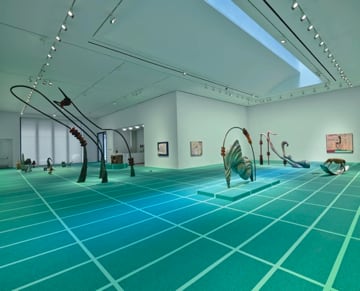
Laura Owens at Matthew Marks Gallery
January 13 - April 19
Laura Owens's latest exhibition at Matthew Marks Gallery offers an immersive experience that redefines the traditional gallery visit. Spanning two adjacent spaces at 522 and 526 West 22nd Street, the exhibition integrates every element into its design, including the employees' desks, which are seamlessly incorporated into the artistic environment. In two of the rooms, Owens has meticulously painted the walls to complement and extend the motifs of her canvases, creating a cohesive and enveloping visual narrative. A third room is dedicated to a series of handmade books she has crafted specifically for this show, inviting visitors to engage intimately with her creative process. This exhibition, running through April 19, 2025, exemplifies Owens's innovative approach to blurring the boundaries between art and its surroundings.

Portraits of Mine Okubo at Seizan Gallery
January 9 - March 1, 2025
Seizan Gallery consistently presents remarkable works of art, and this time is no exception with Portraits by Mine Okubo. This powerful exhibition showcases the resilience and artistic brilliance of Okubo, who, along with her family, was forcibly detained in a Japanese internment camp in the United States during World War II. Despite the harsh conditions of captivity, Okubo created a poignant body of work, secretly documenting the experiences of those around her. Fellow inmates safeguarded her drawings, ensuring they remained hidden from the authorities. After her release, she was able to continue her artistic journey, building an extraordinary career despite the traumas of her past. Portraits stands as both a testament to her strength and a reminder of a dark chapter in American history, making this exhibition a must-see.

and then some more…
there were some exhibitions I just couldn’t leave out. While I tried to keep this list to a strict five, these three additional exhibitions are absolutely worth your time if you have a chance. Whether you’re drawn to cutting-edge contemporary pieces or timeless masterworks, these shows are not to be missed!
Mask by En Iwamura at Ross Kramer Gallery
Jan 30th - Mar 22nd
En Iwamura's latest exhibition, Mask, features over 20 ceramic sculptures, including Iwamura's first wall-hanging pieces. Drawing inspiration from his childhood fascination with global masks at Osaka's National Museum of Ethnology, Iwamura explores the cultural and symbolic significance of masks, reflecting on their historical roles and contemporary relevance in a post-pandemic world. The exhibition also includes works from his Neo Jomon: Stacking Neighbor series, inspired by observing his son engage with the world through play. These vibrant ceramic sculptures, characterized by intricate surface patterns reminiscent of Buddhist Zen gardens and Jōmon-era pottery, invite viewers to reconnect with a sense of curiosity and wonder.
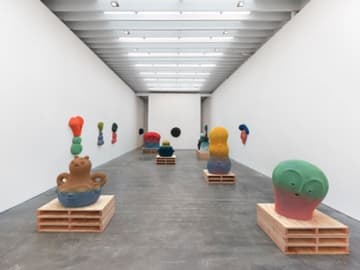
André Butzer at Skarsted Gallery
February 13 - April 26
André Butzer's inaugural solo exhibition at Skarstedt Gallery's Chelsea features ten large-scale paintings and fifteen works on paper, all created specifically for this show. Butzer's work merges European Expressionism with American pop culture, presenting vibrant compositions that explore societal contradictions and human dignity. His distinctive figures, both austere and whimsical, challenge conventional perceptions of humanity, inviting viewers to engage deeply with themes of creation, destruction, and renewal.
Watch Exhibition: André Butzer
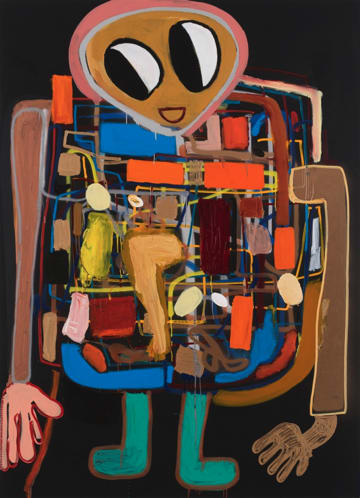
Out of Body by Nathalia Edenmont Nancy Hoffman Gallery
January 30 to March 22
Nathalia Edenmont's exhibition, "Out of Body," marks a significant evolution in Edenmont's artistic journey, featuring 15 photographs and 7 Carrara marble sculptures centered on the motif of eggs, as well as a few marble lilies. These works delve into themes of fertility, fragility, and transformation, reflecting the artist's personal experiences and resilience. Notably, this is Edenmont's first foray into sculpture, expanding her exploration of life's delicate balances through a new medium.

-
Masters of Puerto Rican Art: A Legacy of Culture, Identity, and Innovation
We celebrate the exceptional contributions of Puerto Rican male visual artists who have shaped the island’s cultural identity and artistic legacy. We honor these masters for their creativity, influence, and lasting impact on both Puerto Rican and global art.During Hispanic Heritage Month, we honor the incredible contributions of Puerto Rican male visual artists who have played a pivotal role in shaping the island's artistic and cultural landscape. These artists, including renowned figures like José Campeche, Francisco Oller, Rafael Tufiño, and Lorenzo Homar, have used their talents to express the richness of Puerto Rican identity and heritage. From Campeche’s early portraits and religious scenes to Oller’s groundbreaking role in Impressionism, these artists laid the foundation for Puerto Rican art’s global presence. Tufiño, with his depictions of everyday life and national pride, and Homar, who mastered printmaking techniques and elevated Puerto Rican graphic arts, both carried forward the mission of using art as a vehicle for cultural expression and social commentary.
José Campeche (1751–1809, San Juan) was a prominent Puerto Rican visual artist, often regarded as the first major painter of Puerto Rico and one of the most important in Latin America during the 18th century. Known for his religious and portrait works, Campeche's art masterfully combines Baroque and Rococo styles. He was highly skilled in creating detailed depictions of religious scenes, aristocratic portraits, and landscapes, with his works often reflecting the cultural and social dynamics of colonial Puerto Rico. Campeche is recognized as the first known Puerto Rican visual artist and is considered by art critics to be one of the finest Rococo artists in the Americas. His legacy endures as a pioneering figure in Caribbean art, seamlessly blending European techniques with local themes. Despite never leaving Puerto Rico due to his humble origins and lack of international exposure, his exceptional talent earned him global recognition. His notable work includes Nuestra Señora de la Merced.
Francisco Oller (1833–1917, Bayamon) was a renowned Puerto Rican painter, considered one of the most important figures in Latin American art. He was a pioneer of Impressionism in the Caribbean and the only Latin American artist to have played a significant role in the European Impressionist movement. Oller trained in Spain and France, studying under prominent artists like Courbet and Millet, and his work reflects both European influences and Puerto Rican subjects. His paintings often depicted scenes of Puerto Rican landscapes, everyday life, and social realities. Oller's fusion of realism with impressionist techniques left a lasting impact on Caribbean and Latin American art. El Velorio.
Rafael Tufiño (1922–2008, San Juan) was a key figure in Puerto Rican art, known for his work in painting and printmaking that celebrated Puerto Rican culture and identity. He was part of the island’s mid-20th-century cultural renaissance, using social realism to depict everyday life, traditions, and the working class. His most famous works include the Goyita series, portraits of his mother that became symbolic of the Puerto Rican woman, and El Café, which highlights rural life. Tufiño's art is distinguished by its deep connection to Puerto Rican heritage and its focus on social issues.
Lorenzo Homar (1913–2004, Puerta de Tierra) was a distinguished Puerto Rican visual artist, renowned for his contributions to printmaking, graphic design, and painting. A key figure in the Puerto Rican art movement, Homar played a crucial role in promoting the island's cultural identity through his art. He trained in New York and worked for Tiffany & Co. before returning to Puerto Rico, where he helped establish the Graphic Arts Workshop of the Puerto Rican Institute of Culture. Homar's works often combined political themes, national pride, and social commentary. His mastery of printmaking, especially in silkscreen techniques, left a lasting impact on Caribbean and Latin American art.
Arnaldo Roche (1955–2018, Santurce) was a prominent Puerto Rican visual artist known for his powerful and expressive works that often explored themes of identity, memory, and personal struggle. Roche used bold colors and textured techniques, including his signature frottage method, where images were transferred onto canvas through rubbing. His art frequently dealt with the complexities of Puerto Rican and Caribbean identity, mixing symbolism, personal narratives, and universal themes of human experience. Roche gained international recognition, exhibiting in major museums and galleries worldwide. His emotionally charged and dynamic style solidified his place as one of Puerto Rico's most important contemporary artists.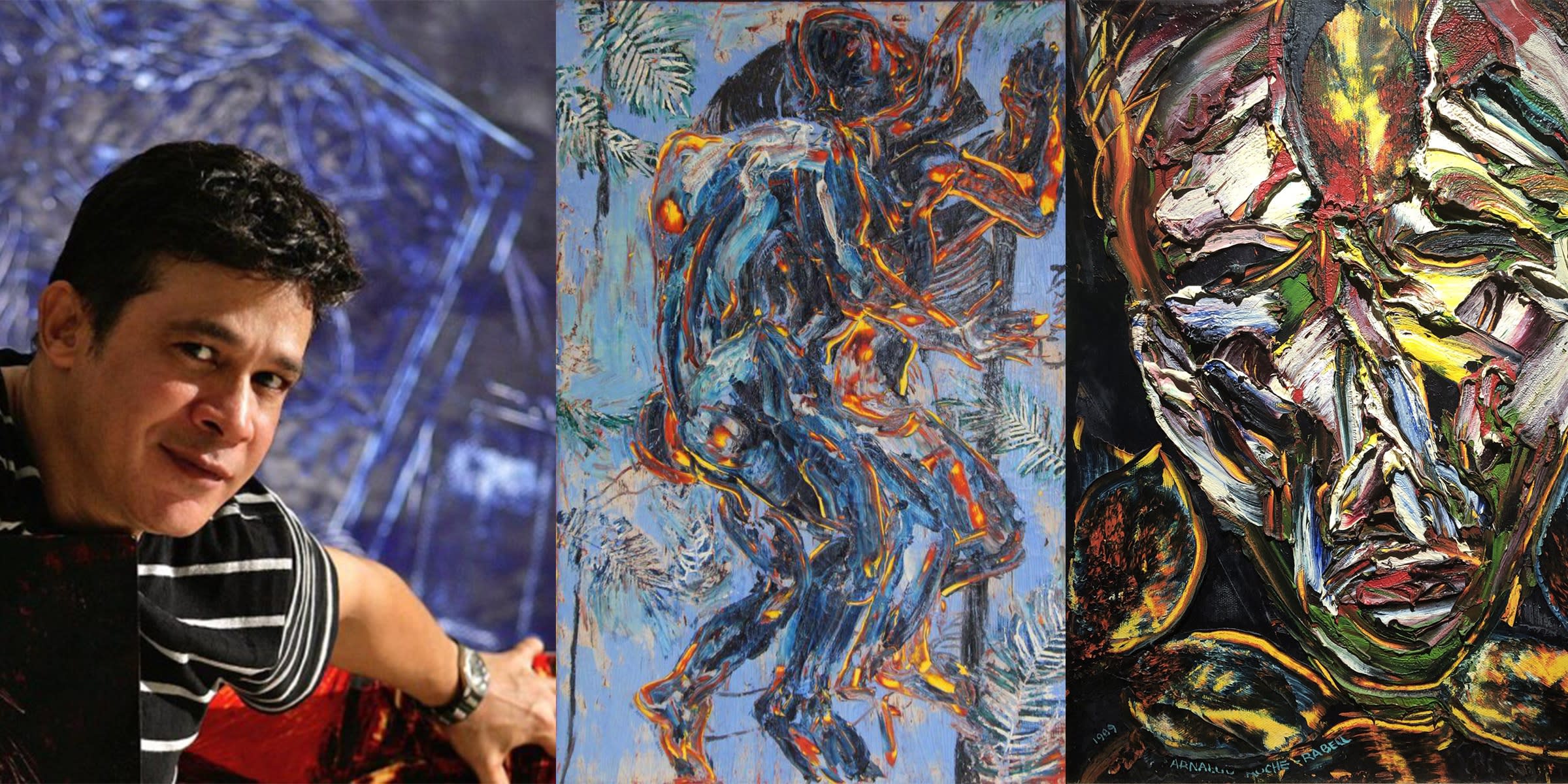
Oscar Colón Delgado (1936–2020, Arecibo) was a respected Puerto Rican visual artist and sculptor known for his contributions to the island's artistic landscape. He specialized in sculpture, creating works that reflected Puerto Rican heritage, culture, and history. Colón Delgado's art often incorporated themes of identity, nationalism, and social issues, using a variety of materials to craft symbolic and monumental pieces. His works were celebrated for their craftsmanship and deep connection to Puerto Rican traditions and stories. Throughout his career, Colón Delgado exhibited widely, both locally and internationally, and became a key figure in Puerto Rican contemporary sculpture, leaving a lasting legacy in the art world.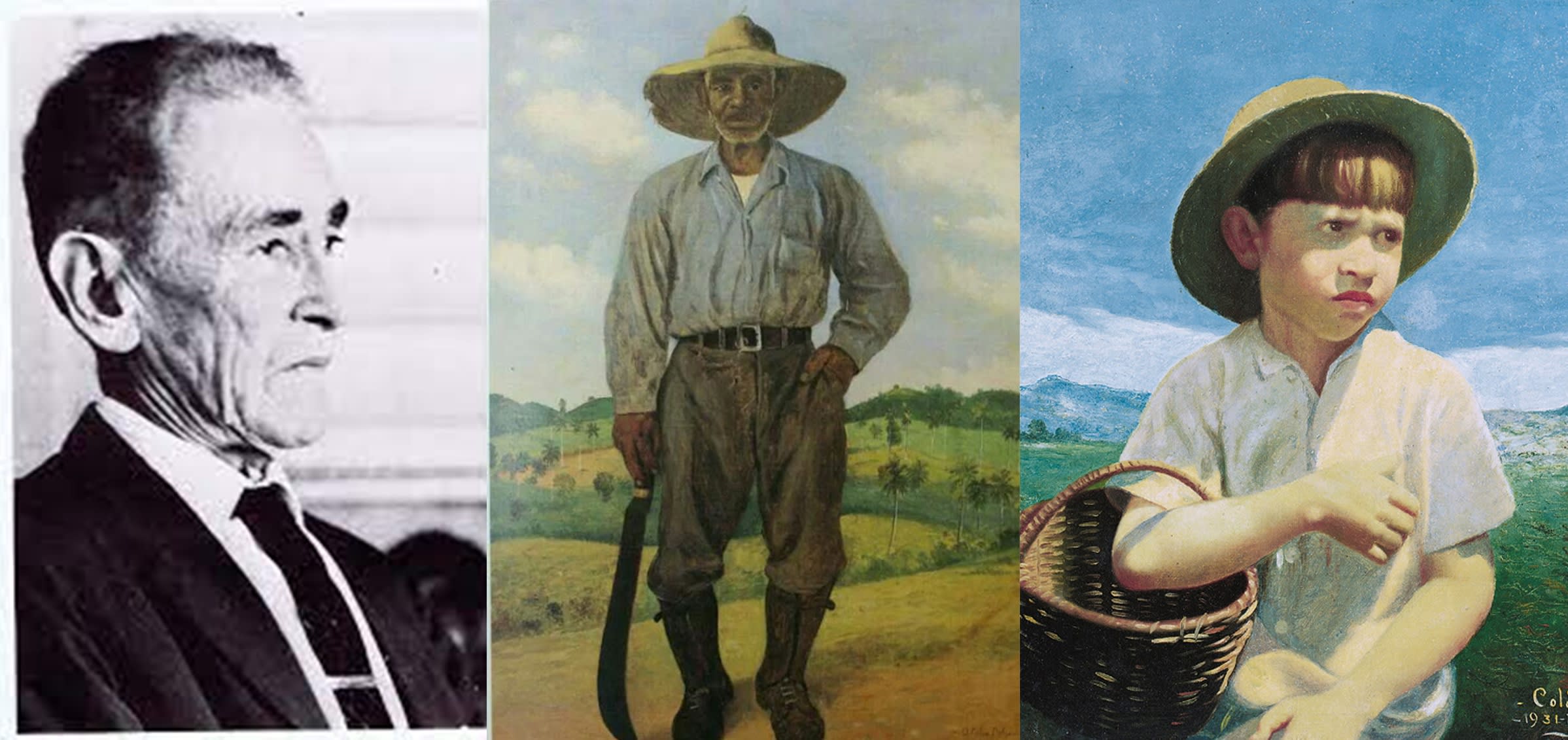
Carlos Raquel Rivera (1923–1999, Yauco) was a Puerto Rican painter and printmaker known for his surrealist and symbolic works that often addressed social and political issues. His art combines elements of Puerto Rican identity with fantastical imagery, exploring themes like oppression, colonialism, and social injustice. Rivera’s famous works include El Barracón, which depicts the hardships of rural Puerto Ricans and their struggle for dignity. His distinctive style, blending surrealism with social commentary, made him a key figure in Puerto Rico's mid-20th-century art scene.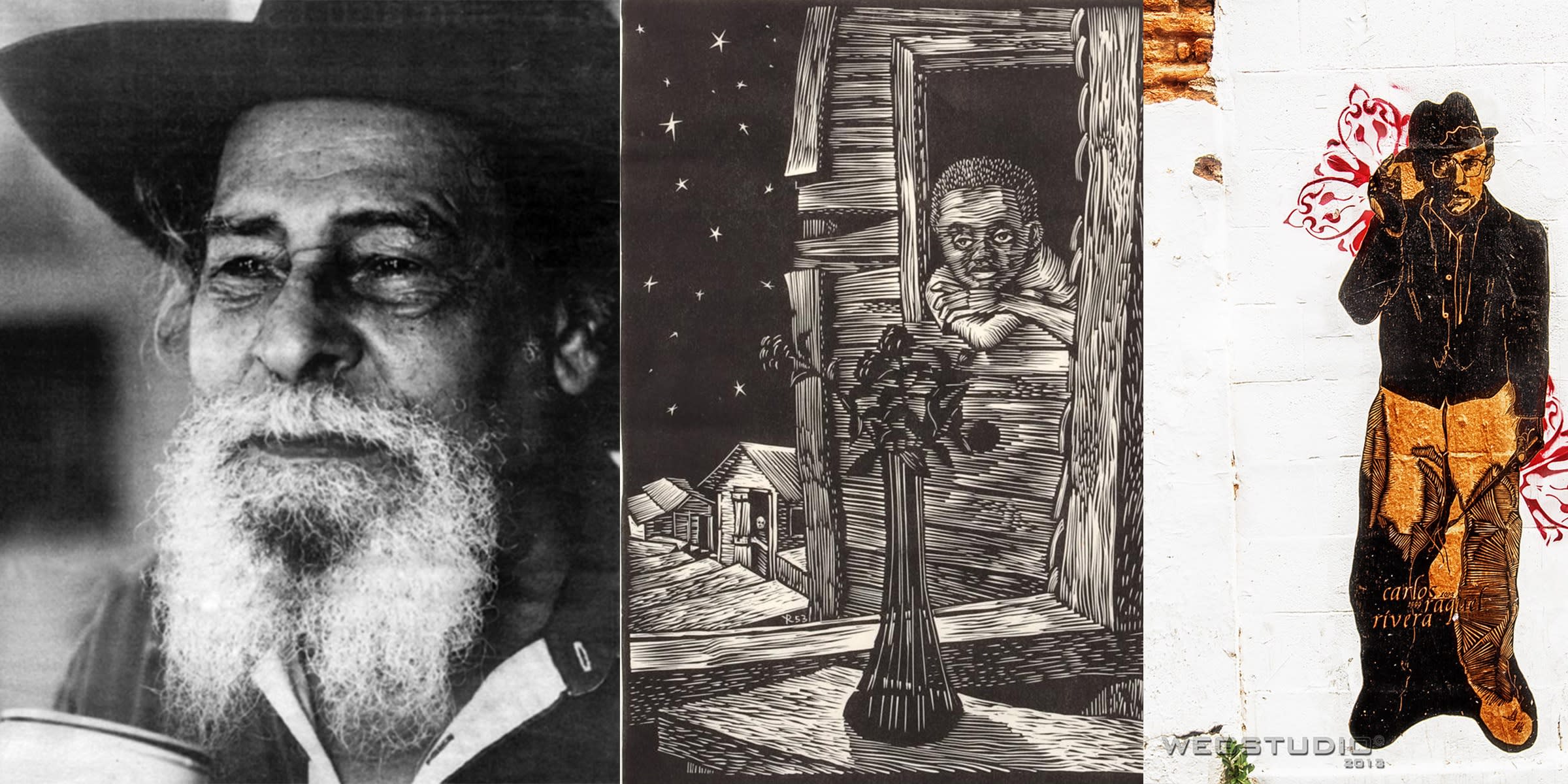 These artists have not only left a lasting impact on the island but have also achieved recognition on the international stage. Their works encapsulate the spirit, resilience, and complexity of Puerto Rican life, from its colonial past to its modern struggles for identity. As we celebrate Hispanic Heritage Month, we remember and honor these visionaries who, through their art, have immortalized the essence of Puerto Rico’s cultural heritage, ensuring that their legacies continue to inspire future generations of artists. Their dedication to capturing the beauty, challenges, and stories of Puerto Rican life has enriched the broader Hispanic artistic tradition.Read more
These artists have not only left a lasting impact on the island but have also achieved recognition on the international stage. Their works encapsulate the spirit, resilience, and complexity of Puerto Rican life, from its colonial past to its modern struggles for identity. As we celebrate Hispanic Heritage Month, we remember and honor these visionaries who, through their art, have immortalized the essence of Puerto Rico’s cultural heritage, ensuring that their legacies continue to inspire future generations of artists. Their dedication to capturing the beauty, challenges, and stories of Puerto Rican life has enriched the broader Hispanic artistic tradition.Read more -

-

-
 Drawing 1
Drawing 1 -
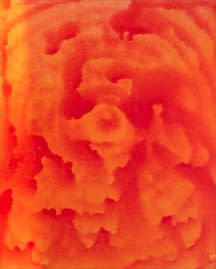
-

Artistic Endeavors for a Cause: CSB FINE ARTS Joins Design on a Dime 2024
SUPPORTING HOUSING WORKS' ADVOCACY FOR EQUITABLE ACCESS TO HIV/AIDS SERVICES THROUGH CREATIVE COLLABORATION -
 A Farewell Chronicle by MA Batalla
A Farewell Chronicle by MA Batalla